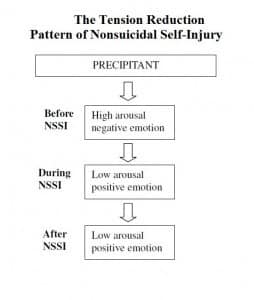Counselling a child to help them to stop their self-harming behaviour is hard work.
Many bewildered parents and novice therapists are unaware of, or overlook, the fact that the behaviour has very powerful psycho-physiological rewards.
Self-harm (or self-injury) is known to slow down heart rate and breathing rates, and floods the body with feel-good endorphins.
The ‘typical’ pattern of nonsuicidal self-injury (NSSI) looks like this:
 Usually, the person will begin by experiencing negative emotions. The individual then reaches a level of distress that s/he is no longer able to tolerate, breathing is shallow and heart rate goes up.
Usually, the person will begin by experiencing negative emotions. The individual then reaches a level of distress that s/he is no longer able to tolerate, breathing is shallow and heart rate goes up.
The act of engaging in self-harm (e.g., cutting) usually occurs with the absence of (or reduced levels of) pain. This is due to increased levels of endogenous opiates such as β-endorphins and encephalins in the body.
The physiology of self-injury is similar to that of “runner’s high”. Damage to the body causes it to flood with “feel good” endorphins, so heart rate and distress reduce significantly. Self-injury then becomes associated with feeling calm/good/better and is very addictive.
Many adolescents who are brought for treatment may not actually be ready to stop the behaviour. It is therefore very important to firstly address the individual’s current motivational stage of change. Put simply, this refers to the question of whether or not the person is actually ready to stop the behaviour.
For many people, self-harm is a maladaptive yet powerful coping strategy which certainly can be improved, but not easily. In a similar way to how a psychologist might work with someone on an addiction, treatment involves ongoing motivational interviewing to get the person to a point where they are consistently able to make a different choice.
Many people who self-harm will try replacement strategies (e.g., snapping a rubber band on their wrist or holding an ice-cube), but the reality is that alternatives may simply not ‘hit the spot’ in the way that self-injury does. Replacement strategies are generally only a temporary solution while the individual is learning to engage longer term strategies such as relaxation and emotion regulation training.
Of course, these longer term strategies require ongoing commitment and practice, and again do not offer the instant gratification that is felt with self-harm.
Generally speaking, it is difficult to stop someone from using a maladaptive coping strategy until they have fully mastered and are comfortable with using an alternative. This is often why adolescents and parents and caregivers clash. They simply have different goals and expectations.
The parents and therapist want the adolescent to stop the behaviour, but the adolescent usually just wants to feel better. They are often scared or angry at the prospect of someone trying to take their coping strategy away from them, and feel guilty because they can’t meet others’ expectations.
The good news is that with ongoing, long-term, non-judgmental support many young people who self-injury will learn alternative coping strategies and be able to significantly reduce the overall number of episodes.
For individuals who work hard and make it past the 12 month anniversary since the cessation of self-harm they often feel an immense sense of achievement, and confidence in their ability to cope. They may still feel the ‘urge’ for many years to come, but the power is in learning that they are in control of their own emotions and don’t need to act on every urge that surfaces.
References
- Brain, K. L., Haines, J., & Williams, C. L. (2002). The psychophysiology of repetitive self-mutilation. Archives of Suicide Research, 6(3), 199-210. doi:http://dx.doi.org/10.1080/13811110214140
- Brain, K. L., Haines, J., & Williams, C. L. (1998). The psychophysiology of self-mutilative behaviour: A comparison of current and recovered self-mutilators. (pp. 211-222) Plenum Press, New York, NY.
- Haines, J., & Williams, C. L. (2003). Coping and problem solving of self-mutilators. Journal of Clinical Psychology, 59(10), 1097-1106. doi:http://dx.doi.org/10.1002/jclp.10202
- Klonsky, E. D. (2007). Non-suicidal self-injury: An introduction. Journal of Clinical Psychology, 63(11), 1039-1043.

